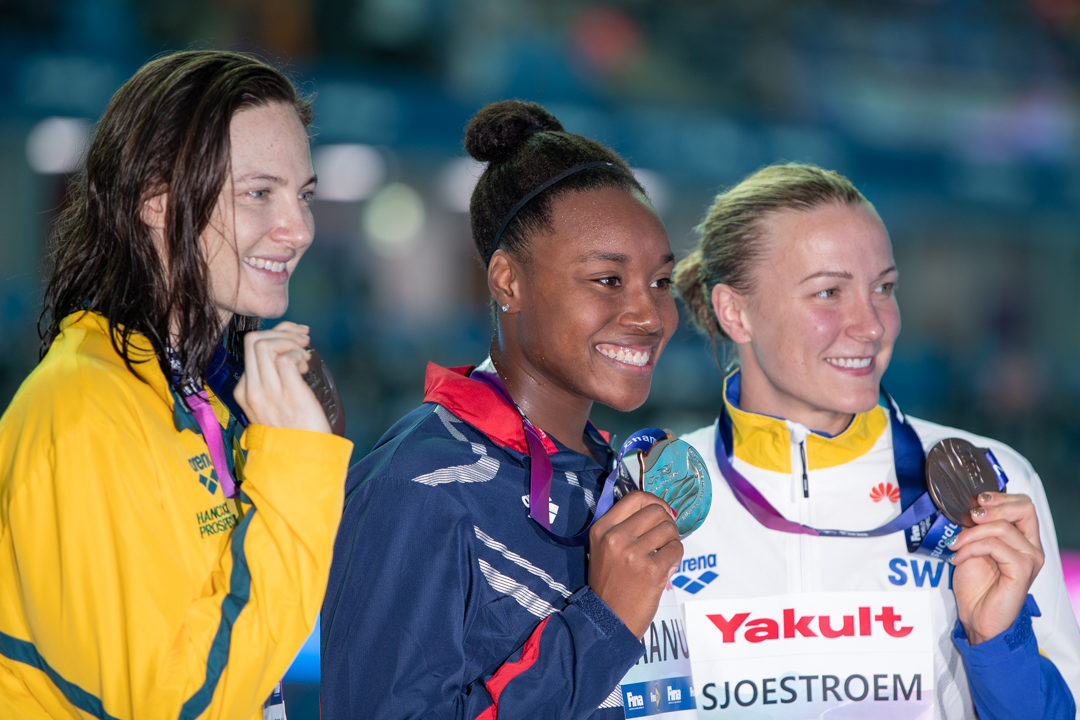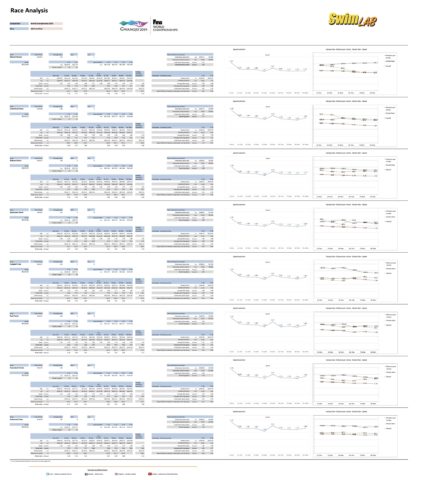Here we come with our second analysis of the 2019 World Championship‘s final.
It is time to study (but in a fun way)!
- To see a discussion of the information in these analyses, click here.
- Click here for the analysis of the final of men’s 100m free
WOMEN 100M FREESTYLE – FINAL
- Simone Manuel
- Mallory Comerford
- Emma McKeon
- Sarah Sjostrom
- Cate Campbell
- Taylor Ruck
- Femke Heemskerk
- Freya Anderson
Race Video (only highlights have been published for public use):
The analysis of the women’s 100 freestyle shows us a lot of interesting data that lead to some noteworthy remarks.
SPLITS AND LAPS
First of all, let’s check the splits and laps.
The first 50-meter average is 25.39 while the average time of the second half is 27.41 with a difference of 2.02.
That difference is very similar both for the first three swimmers and for the last five: 2.09 for the first three and 1.98 for the last five. The balance of the race is not so different between these two groups.
The average time for the first 50m is 25.11 for the first three athletes. 25.56 for the last five.
In the second 50m we recorded an average time of 27.20 for the first three athletes and of 27.54 for the last five ones.
To get a medal in 100 freestyle in Gwangju it was a bit more important to be faster in the first 50m than in the second 50m.
This data is interesting. If we take into consideration the men’s 100m freestyle, we notice that the trend is just the opposite – even if the difference is not so considerable.
In the men’s race, the second 50m was more important than the first one.
Like for the men, the first 15m played an important role for the women as well.
The gap between Simone Manuel and all the others is considerable (6.07 for her, and 6.24 for the second, third and fourth athletes). Considering all the finalists, the average is 6.30 seconds.
The turn time is remarkably similar for all of the swimmers, so it does not make any big difference. It does not mean that the turn is not important but that the general level of all the swimmers is very high.
There is a strict connection with the 100m men: the balance between distance per stroke and stroke rate/ stroke tempo is similar.
THE AVERAGE VALUE
The average value of stroke rate for the first three athletes is 48.5 stroke/minute (1.24 second stroke tempo) and 49.9 strokes/minute (1.20 second stroke tempo).
It’s definitely not a huge difference!
But again, like for men, the main difference between the first three and the last five athletes is the distance per stroke. 224.9cm for the first three and 215.3cm for the last five swimmers. The difference is 9.6cm.
These data are not statistically significant as the number of the athletes is not enough, but they give us a clear picture of the final in Korea: it is undoubtedly interesting to observe that like for men the key point is the ability to apply strength to the water.
Underwater phase
The underwater phase shows us some unexpected data.
After the start, the length is just a little bit longer for the first three, just 9cm, while the difference in speed is very small (2.61m/s for the first three vs 2.57m/s for the last five).
The unexpected part is the underwater phase after the turn. It’s 19cm longer but slower for the first three athletes if compared to the last five swimmers. 6,98m for the first three with 2.27m/s vs, 6.79m and 2.37m/s for last five.
We have already noted the turn. From 45m to 65m the first three swimmers are faster and that means that they are faster in the swimming part after the breakout.
This issue could be interesting if someone is looking for the marginal gains!!!
In conclusion
The first 15meters are decisive to get a medal, the main difference is the distance per stroke and the ability to apply power to the water.
This story comes courtesy of STEFANO NURRA
- Analyst of Turkish Swimming Federation
- Analyst of Energy Standard
- Owner of Swimlab



Manuel blasted off the blocks like a woman on a mission. And out in lane 1, her main competitors couldn’t see her. She kept the momentum going and no one was close the whole race.
Nice analysis